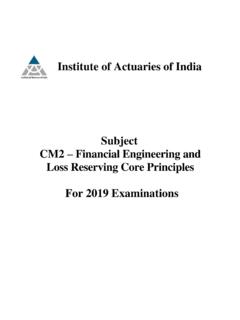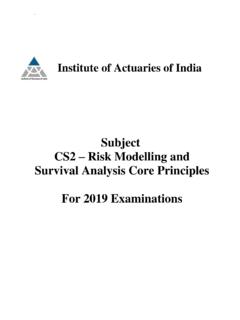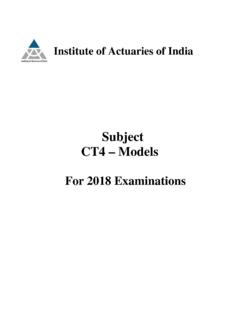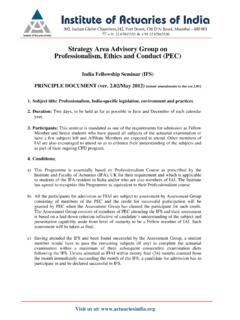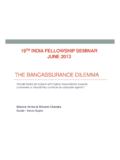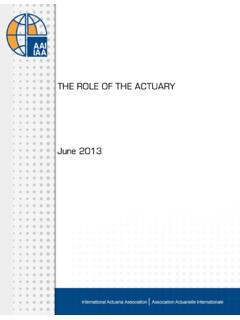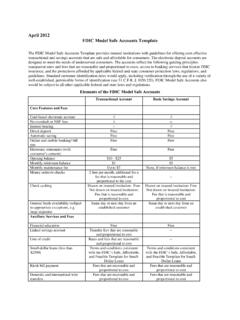Transcription of Subject CM1 Actuarial Mathematics Core Principles For 2019 ...
1 Institute of Actuaries of India Subject CM1 Actuarial Mathematics core Principles For 2019 Examinations CM1- Actuarial Mathematics core Principles Page 1 of 10 Aim The aim of the Actuarial Mathematics 1 Subject is to provide a grounding in the Principles of modelling as applied to Actuarial work focusing particularly on deterministic models which can be used to model and value known cashflows as well as those which are dependent on death, survival, or other uncertain risks. Competences On the successful completion of this Subject , the candidate will be able to: 1 2 3 describe the basic Principles of Actuarial modelling. describe, interpret and discuss the theories on interest rates.
2 Describe, interpret and discuss mathematical techniques used to model and value cashflows which are contingent on mortality and morbidity risks. Links to other subjects Concepts are introduced in: CS1 Actuarial Statistics 1 Topics in this Subject are further built upon in: CM2 Financial Engineering and Loss Reserving CB1 Business Finance CP1 Actuarial Practice CP2 Modelling Practice SP1 Health and Care Principles SP2 Life Insurance Principles SP4 Pensions and other Benefits Principles CM1- Actuarial Mathematics core Principles Page 2 of 10 Syllabus topics 1 2 3 4 5 6 Data and basics of modelling (10%) Theory of interest rates (20%) Equation of value and its applications (15%) Single decrement models (10%) Multiple decrement and multiple life models (10%) Pricing and reserving (35%)
3 The weightings are indicative of the approximate balance of the assessment of this Subject between the main syllabus topics, averaged over a number of examination sessions. The weightings also have a correspondence with the amount of learning material underlying each syllabus topic. However, this will also reflect aspects such as: the relative complexity of each topic, and hence the amount of explanation and support required for it. the need to provide thorough foundation understanding on which to build the other objectives. the extent of prior knowledge which is expected. the degree to which each topic area is more knowledge or application based.
4 Skill levels The use of a specific command verb within a syllabus objective does not indicate that this is the only form of question which can be asked on the topic covered by that objective. The Examiners may ask a question on any syllabus topic using any of the agreed command verbs, as are defined in the document Command verbs used in the Associate and Fellowship written examinations . Questions may be set at any skill level: Knowledge (demonstration of a detailed knowledge and understanding of the topic), Application (demonstration of an ability to apply the Principles underlying the topic within a given context) and Higher Order (demonstration of an ability to perform deeper analysis and assessment of situations, including forming judgements, taking into account different points of view, comparing and contrasting situations, suggesting possible solutions and actions, and making recommendations).
5 In the CM subjects, the approximate split of assessment across the three skill types is 20% Knowledge, 65% Application and 15% Higher Order skills. CM1- Actuarial Mathematics core Principles Page 3 of 10 Detailed syllabus objectives 1 Data and basics of modelling (10%) Data analysis Describe the possible aims of a data analysis ( descriptive, inferential, and predictive). Describe the stages of conducting a data analysis to solve real-world problems in a scientific manner and describe tools suitable for each stage. Describe sources of data and explain the characteristics of different data sources, including extremely large data sets.
6 Explain the meaning and value of reproducible research and describe the elements required to ensure a data analysis is reproducible. Describe the Principles of Actuarial modelling. Describe why and how models are used including, in general terms, the use of models for pricing, reserving, and capital modelling. Explain the benefits and limitations of modelling. Explain the difference between a stochastic and a deterministic model, and identify the advantages/disadvantages of each. Describe the characteristics of, and explain the use, of scenario-based and proxy models. Describe, in general terms, how to decide whether a model is suitable for any particular application.
7 Explain the difference between the short-run and long-run properties of a model, and how this may be relevant in deciding whether a model is suitable for any particular application. Describe, in general terms, how to analyse the potential output from a model, and explain why this is relevant to the choice of model. Describe the process of sensitivity testing of assumptions and explain why this forms an important part of the modelling process. Explain the factors that must be considered when communicating the results following the application of a model. CM1- Actuarial Mathematics core Principles Page 4 of 10 Describe how to use a generalised cashflow model to describe financial transactions.
8 State the inflows and outflows in each future time period and discuss whether the amount or the timing (or both) is fixed or uncertain for a given cashflow process. Describe in the form of a cashflow model the operation of financial instruments like a zero coupon bond, a fixed interest security, an index-linked security, cash on deposit, an equity, an interest only loan, a repayment loan, and an annuity certain; and an insurance contract like endowment, term assurance, contingent annuity, car insurance and health cash plans. 2 Theory of interest rates (20%) Show how interest rates may be expressed in different time periods. Describe the relationship between the rates of interest and discount over one effective period arithmetically and by general reasoning.
9 Derive the relationships between the rate of interest payable once per measurement period (effective rate of interest) and the rate of interest payable p (> 1) times per measurement period (nominal rate of interest) and the force of interest. Calculate the equivalent annual rate of interest implied by the accumulation of a sum of money over a specified period where the force of interest is a function of time. Demonstrate a knowledge and understanding of real and money interest rates. Describe how to take into account time value of money using the concepts of compound interest and discounting. Accumulate a single investment at a constant rate of interest under the operation of simple and compound interest.
10 Define the present value of a future payment. Discount a single investment under the operation of a simple (commercial) discount at a constant rate of discount. Calculate present value and accumulated value for a given stream of cashflows under the following individual or combination of scenarios: Cashflows are equal at each time period. Cashflows vary with time which may or may not be a continuous function of time. CM1- Actuarial Mathematics core Principles Page 5 of 10 Some of the cashflows are deferred for a period of time. Rate of interest or discount is constant. Rate of interest or discount varies with time which may or may not be a continuous function of time.
